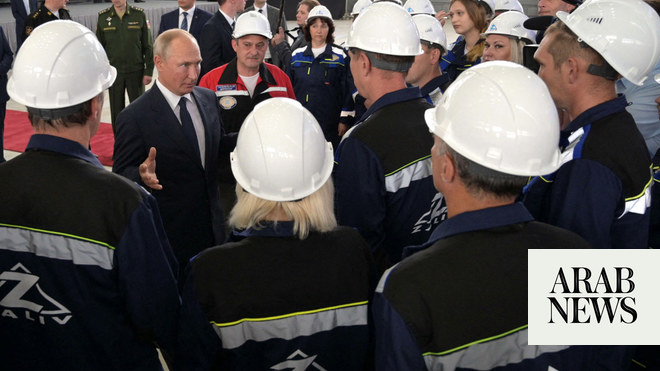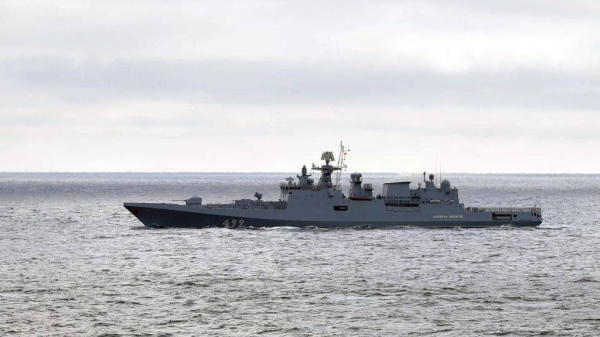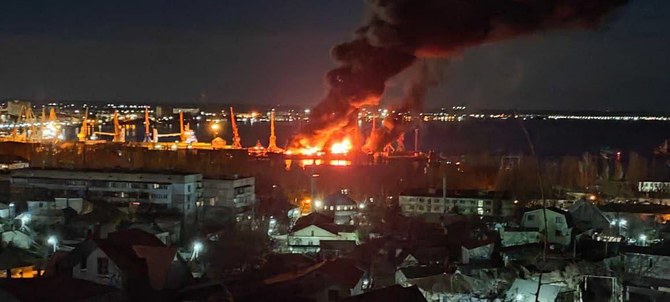
A Russian airbase deep behind the frontline in Crimea has been damaged by several large explosions, killing at least one person, although it was not immediately clear whether it had been targeted by a long-range Ukrainian missile strike.
Multiple social media videos showed explosions and clouds emerging from the Saky military base in Novofedorivka on the western coast of Crimea on Tuesday afternoon, prompting questions about how a location more than 100 miles (160km) from the frontline could have been attacked. Later a senior Ukrainian official appeared to claim responsibility, without giving details.
Russia’s defence ministry told the RIA Novosti news agency that the explosions took place at about 3.20pm local time, and that “several aviation munitions detonated” in a storage area. It said it was trying to discern the cause of the incident.
Russian tourists holidaying on beaches nearby could be seen leaving in fear. It is one of few occasions that the peninsula, occupied by Russia since 2014, has been directly affected by the latest fighting. Local people told one Russian news site that explosions went on for an hour.
Sergey Aksyonov, the Russian-appointed head of occupied Crimea, said one person had died. Earlier, he had filmed a video statement near the site, with smoke rising in the distance, saying that ambulance crews and medics were on the scene.
Ukrainian officials were slower to comment on the incident but in the early evening, one adviser to the president, Mikhail Podolyak, appeared to suggest the strike could herald a new phase of the conflict.
Podolyak said that Kyiv’s long-term goal was “demilitarisation of the Russian Federation”. He added: “The future of the Crimea is to be a pearl of the Black Sea, a national park with unique nature and a world resort. Not a military base for terrorists. It is just the beginning.”
Ukraine’s defence ministry said it could not determine the cause of the explosions but added, sardonically, that people should have regard for the rules of fire safety and “the prohibition of smoking in unspecified places”.
The airbase, where Franklin Roosevelt and Winston Churchill landed en route to the Yalta conference in February 1945, is too far – about 110 miles – from the frontline to be struck by conventional land-based Ukrainian rockets. It could, however, be in range of other longer-range systems.
In the previous 24 hours there had been growing speculation about Ukraine’s missile capability after the US confirmed, for the first time, that it had supplied Kyiv with long-range anti-radiation missiles, used to knock out air defence systems.
Advertisement
A Pentagon spokesperson said on Monday that the US had previously supplied a number of the weapons to Ukraine, but declined to say how many or of what type. The weapons are widely believed to be the AGM-88 high-speed anti-radiation (Harm) missile, a tail fin of which was being circulated by Russian bloggers on Sunday. They are typically launched from a plane and have a maximum range of about 90 miles.
Over the last month, Ukraine has shown it is able to strike deeper and deeper into Russian-held territory using the Himars rocket artillery, which has a range of about 50 miles.
However, there were other suggestions that the Saky base was hit by a guerrilla operation. Margarita Simonyan, the editor-in-chief of the state-owned Russia Today outlet, appeared to suggest in a tweet that the explosions were caused by sabotage – although she later said the explosion was caused by “several munitions” detonating in storage.
In her later posts, Simonyan said there had been no missile strikes and added that claims Kyiv’s forces could strike 300km (186 miles) were “Ukropropaganda”. She advised people to “exhale and go to the beach”. Other videos, however, showed traffic jams forming as people sought to flee Crimea.
The Saky airbase is about 165 miles from the Ukrainian city of Odesa, prompting speculation it could have been targeted by Neptune missiles previously used to knock out the Russian Moskva warship. The anti-ship missiles have a range of about 190 miles and can be used to hit ground targets.
A Ukrainian official, speaking anonymously, told the New York Times that “a device exclusively of Ukrainian manufacture was used” in the attack. That could suggest it was a Neptune, a cruise missile developed by Ukraine and which first became operationally available in the early phases of the war.
Earlier on Tuesday, officials said at least three Ukrainian civilians were killed and 23 were wounded by Russian shelling in 24 hours, including in an attack not far from the Russian-occupied Zaporizhzhia nuclear power plant.
The governor of Dnipropetrovsk region, Valentyn Reznichenko, said that Russian forces firing more than 120 rockets at the town of Nikopol, across the Dnieper River from the plant, damaged several apartment buildings and industrial sites.
Advertisement
The prime ministers of Estonia and Finland have called on fellow European countries to stop issuing tourist visas to Russian citizens, saying they should not be able to take holidays in Europe while the Russian government carries out a war in Ukraine.
Kaja Kallas, the Estonian prime minister, said on Tuesday that “visiting Europe is a privilege, not a human right” and that it was “time to end tourism from Russia now”, a day after a similar appeal from her counterpart in Finland, Sanna Marin.
Ukraine’s president, Volodymyr Zelenskiy, went further in a Washington Post interview on Monday and called for a full travel ban and the expulsion of Russians who had moved to the west. The Kremlin spokesperson, Dmitry Peskov, said the idea amounted to “irrational thinking”.












